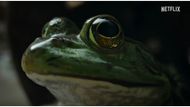Netflix docuseries Nightmares of Nature was filmed mainly in Georgia, with primary shooting on location in the Gaskins Forest Education Center in Alapaha, as well as some scenes shot within Atlanta facilities.
Season 1, Cabin in the Woods, was shot against a background of a "creepy New England forest" on settings that spanned across dark southeastern United States forests, specifically in the varied natural scenery found in the state of Georgia, in an attempt to emulate the eerie North American wilderness.
Season 2, Lost in the Jungle, was shot in Central America, but this time set in a remote rainforest in Costa Rica, a specific "abandoned Costa Rican jungle camp" that heightens the gloomy mood typical of the series.
This location was chosen due to its biodiversity, plus the natural perils of the jungle ecosystem, serving as a complement to the show's theme as a survival show.
Narrated by Maya Hawke and produced by Blumhouse Television and Plimsoll Productions, Nightmares of Nature mixes real wildlife footage with a horror-tinged narrative style. Season 1 was released on September 30, 2025, and follows the lives of three animals: a pregnant mouse, a raccoon fawn, and a bullfrog, through real perils in the wild, such as predators and natural disasters.
Season 2 will be released on October 28, 2025. It revolves around a young opossum's survival story, an iguana that has just hatched out of its eggs, and a jumping spider surviving off the perilous jungle terrain.
Filming locations of Nightmares of Nature

The Nightmares of Nature was heavily inspired by real-world locations so viewers could have an intense, immersive experience. A description of the main locations that they used per scene follows:
The Gaskins Forest Education Center, located at 3359 Moore Sawmill Road in Alapaha, Georgia, is a key aspect since it is the main location of filming outdoors, as reported by Moviedelic. Its woodland landscape is preserved, which presents a genuine forest habitat that is essential in the filming of the documentary about nocturnal animal behavior, survival strategies, and the spooky natural habitat.
The ecosystem of the center is highly diverse in terms of flora and fauna, dense with adult foliage, which provides the most comfortable environment when depicting animals in their natural environment, including their interactions with bears, deer, and other smaller forest inhabitants.
Due to the frequent utilization of the location as a venue where educational workshops are held in the fields of botany, wildlife, and hydrology, the location has been beneficial in its ecological richness and access to pristine natural environments, which gives the filming an authentic and rich look.
Certain scenes were shot using resources and facilities of the Georgia Department of Natural Resources (DNR) in Atlanta, the outlet added. These scenes primarily focused on controlled wildlife observation and detailed close-ups that required specialized equipment and settings unavailable in the wild.
The DNR agreement offered scientific credibility, as its location in a metropolitan region assisted in offering logistical support for the crew. The departmental expertise assisted in offering species-specific research, descriptions of the environment, and expert insight on footage that broadened the educational value of the documentary.
Nightmares of Nature Season 2 changed its filming location to Central America, more specifically, the rainforests in Costa Rica, due to its rich biodiversity and frequent appearance in nature documentaries. The team shot a substantial amount in an "abandoned jungle camp," also described by Netflix promotional content and the main trailer. The jungle camp is a deserted and isolated place that symbolizes the danger that the young animal characters, such as the opossum, iguana, and jumping spider, face.
Abandonment as well as isolation increase the peril as well as vulnerability, as the story visually exemplifies the deadly survival realities where the natural world is a refuge as well as a threat. The rainforests of Costa Rica, lush with vegetation, capricious climatic patterns, and teeming wildlife, create a suitable backdrop for Nightmares of Nature's Lost in the Jungle narrative arc.
What’s on Netflix quoted Head of Plimsoll USA, Alan Eyres, as saying:
“It’s only natural to be scared about the things that go bump in the night, but Nightmares of Nature isn’t a projection of the supernatural. Once you start looking at the natural world, you will find things as terrifying as anything in a horror movie. To tell that story, we could not hope for better collaborators than Blumhouse. Combining the world’s greatest horror filmmakers with some of the world’s best natural history storytellers is a unique opportunity to create a more visceral, emotional point of entry to nature than anything we’ve seen before.”
